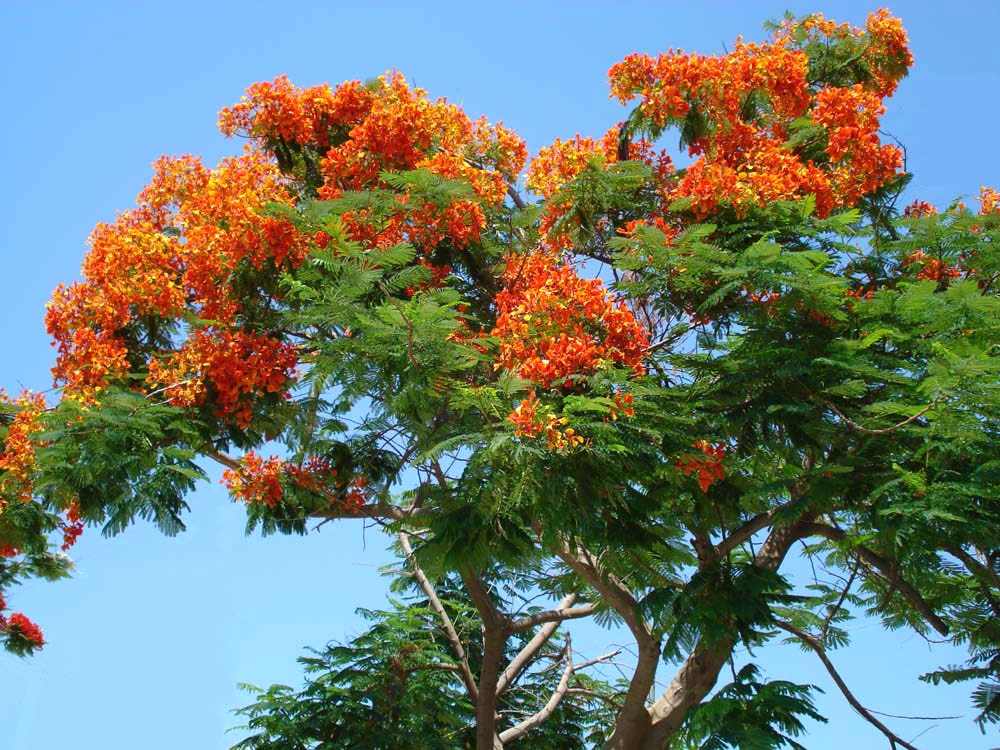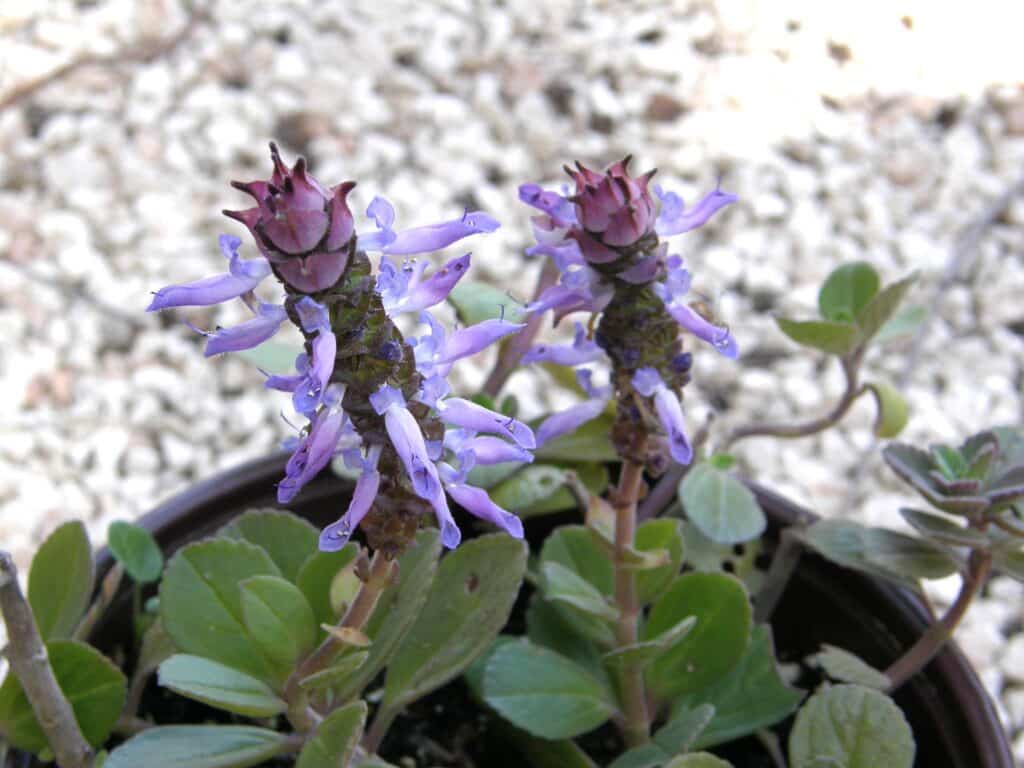By Patricia Jordan
‘High summer’ in the garden here brings out the amazing flowers of tropical and semi-tropical trees. If you live along the coastline then you will be able to enjoy Delonix regia or the ‘flame tree’, as it is commonly known, when the branches thrust upwards with masses of flaming orange flowers, which contrast so well with the brilliant blue skies.
In the coastal towns you will also see the occasional frangipane, which loves humidity and is a favourite of mine, although sadly I can’t grow at home at 300 metres. You may not be able to grow them in your garden either, as these are both very tall trees reaching around 9 metres and also need some space for sideways growth.
So, what can you grow that won’t dominate your garden and yet give you colour and interest at this time of year.
Caesalpinia gilliesii, is a pretty drought-tolerant smaller tree with racemes of stunning five-petalled flowers, with ten very long bright-red stamens that dance in any summer breeze.
Duranta erecta, originally discovered growing in Florida, Brazil and the Caribbean Islands, is a large sub-tropical shrub or small tree and ideal for many gardens. The arching stems carry trails of sky-blue flowers on their tips attracting many butterflies and there is the bonus of a delightful fragrance. The flowers mature into little strings of orange berries just like beads, greatly loved by pigeons and other birds.
Tecoma stans is thrusting skywards along the coastline but grows equally well at higher elevations, showing off its brilliant yellow flowers amongst bright-green leaves. A native of tropical America, it grows extremely well in other parts of the island too.
There are of course many climbers in flower at this time of year. Whilst honeysuckle may have passed its best, bougainvillea will be shouting at you from the rooftops with its bracts of many colours, as it scrambles up supports and trees.
Campsis radicans is a rampant grower, so you have to be careful where you plant it, as it is heavy and likely to bring any supports down if they are not secure.
A more gentle climber is Hoya carnosa. This lovely native of Eastern Asia and Australia will grow outdoors very successfully as long as it has some shade from the midday sun and it does very well in a pot. The pretty pink star-shaped flowers, attractive to bees and butterflies, appear on leafless spurs. When the flowers die, it is important not to cut off these spurs, as new flowers will appear in the same place next season.
What to do in the garden in July
It is going to be very hot from now on until October, so make sure that you have plenty of shade to sit under. Not all trees are suitable however and you will see that many village people have a vine under which they can eat and talk at any time of the day or evening. Vines are often supported by a scaffolding pole structure due to the weight of a vine in full leaf and laden with ripening grapes. You could use a pergola for other plants, but take care that that the sun cannot burn you through any frondy leaves. Whilst they filter the hot air which helps the plant, they can also let sunlight through onto you.
Even though it is hot, it is still possible to grow some salad crops if you have a shady spot in the garden or even on a veranda if you live in an apartment. Garden centres have lots of plugs making a quick start to harvesting your crops and what is better than picking your own from a pot or garden. Herbs, too, are very useful plants to have around, as many have leaves full of oils which are exuded during the day that lots of unfriendly insects do not like and therefore bypass these plants.
Lots of gardeners who grow their own vegetables and salads are averse to using any chemicals these days because of the hidden problems associated with them. Long before there were any chemical controls for the pests that appeared with alarming regularity, gardeners would plant other crops in between the rows to deter insects from eating the vegetables, and it is enjoying something of a renaissance. It is all about giving nature a helping hand by planting useful deterrents in your garden or plot.
The most well-known companion planting is to grow Tagetes (Marigolds) amongst tomatoes and other plants as their distinctive smell deters greenfly and blackfly. Garlic, too, will give aphids a blow. Nasturtiums, such pretty annuals, can do a great job in the garden. Not only will they keep aphids off broccoli but squashes and pumpkins too. Their strong smell will keep any cabbages free from Cabbage White butterflies and protect your radishes and fruit trees too. The flowers can also be tossed into salads adding colour and zing to a meal.
Melons, courgettes and cucumbers will be growing at a fast pace and the sweet tomatoes to accompany them will need some daily watering. I always advise sinking a plant pot next to a tomato plant and put the water in that, so it reaches directly to the roots. They do enjoy regular watering or they may split.
I love to grow sweet corn too. Usually planted around the end of April from plugs, it is fun to watch them grow. Sweet corn plants are wind pollinated so should be planted close together so that the pollen from the males reaches all the female tassels. They are so much tastier straight from the garden.
Ripening prunus fruits like apricots, nectarines and peaches are likely to attract Med flies, as are figs, which are looking luscious now. They are also well liked by birds, so you may have to keep an eye open for them. Always do any necessary work in the evenings after the sun is off your garden. It is tempting to plant and work in the early morning when everything is bright and rested, but any new plants will have to endure the heat of the day.
The flower garden may need some attention as well with dead heading and seed collecting. Lots of herbs will benefit from a trim to encourage new growth and not to get too leggy. Of course, at this time of year watering is a daily chore. Whilst you can use ‘grey’ water for flowering plants which also helps to keep the bugs off, do not use it for anything you are going to eat. Your pots and planters which were planted up in early spring may need to be refreshed.
Garden centres are always full of annuals which you can plant up easily even if you live in an apartment and only have a small veranda. Petunias, from South America don’t seem to mind the heat and pelargoniums, from South Africa, just love it all, provided they are well watered and fed occasionally. Do this in the cool of the day or first thing in the morning making sure that the water goes straight to the soil and not on the leaves or petals. Some of the little succulent-type plants like portaluca do well especially at this time of year and have small multi-coloured flowers that will delight you.
Plant of the Month – Plectranthus neochilius
Plectranthus neochilius, found mostly in southern and tropical Africa and Madagascar, are great ground-cover perennial plants growing to eventually 50-60cm. Members of the large sage family, they are ideal for hot Mediterranean borders, although they may die if subjected to cold nights during the winter. The best location to grow this plant is in a partly shaded border. This southern-hemisphere beauty can adapt well to high temperatures with the minimum of water.
It is also salt-spray and wind-tolerant, and although it prefers to grow in well-drained loamy soil, it can grow just as well in sandy soil. The succulent grey-green leaves are toothed or wavy edged and the prolific two-lipped flowers are small but attractive and in a very pretty shade of blue, appearing atop very short stems. The plants can be used in containers or hanging baskets, but be aware as growth is rapid the plants may need to be kept in trim. In the ground, they can spread quickly and become invasive.
Stems root easily in water at any time, or from ‘green’ cuttings. Mealy bugs and spider mites can sometimes be problematic, and root rot can occur from over-watering. Here in Cyprus its common name is ‘snake plant’ as it is said that these aromatic plants will keep snakes away from houses and gardens. In other countries where they are grown ‘spur flower’ is the common name. The plants can cope with shortages of watering from time to time, and the stems can go woody after a while, but if the plant is kept trimmed, then this is not a problem.








Click here to change your cookie preferences